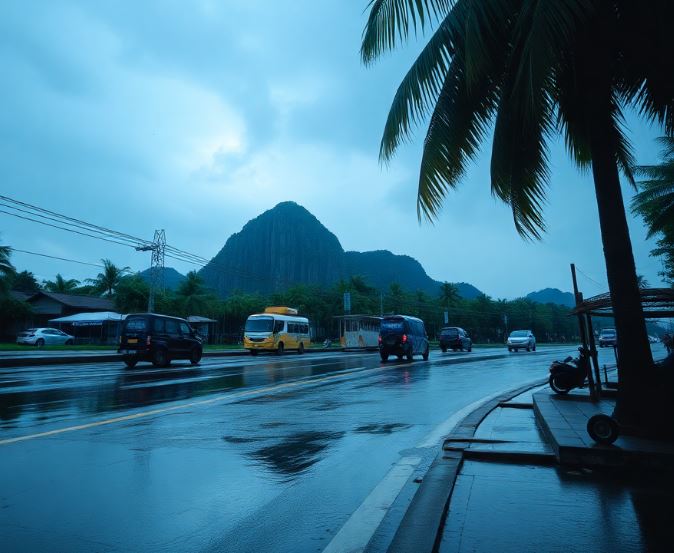
Estimated reading time: 8 minutes
It’s March 2025, and as summer looms, Thailand’s monsoon season—spanning May to October—beckons with a twist. Once a deterrent, this “green season” is flipping the script, drawing travellers to its lush landscapes, quieter shores, and wallet-friendly deals. In 2024, Thailand welcomed 35.3 million visitors, with off-peak months like September seeing a 15% uptick from 2023, per the Tourism Authority of Thailand. Far from a washout, the rainy season offers a vibrant, authentic escape—think emerald rice paddies, misty mountains, and cultural gems without the crowds. This article dives into why monsoon travel is Thailand’s hottest ticket for 2025, unpacking its allure, top destinations, and practical know-how.
The Green Season Glow-Up
Thailand’s monsoon isn’t the dreary deluge you might imagine. The southwest monsoon sweeps warm, moist air from the Indian Ocean, drenching the land in bursts—often an hour or two, rarely all day—cooling the tropical heat. June averages 29°C in Bangkok, with humidity at 80%, per Weather2Travel, but the rain transforms the scenery. By August, rice fields gleam green, waterfalls roar, and flowers burst into life—an eco-traveller’s dream.
Economically, it’s a win. A 2024 Lonely Planet report noted hotel rates drop 20-40% in the wet months—think £30 a night for a Phuket beachfront stay versus £60 in January. Flights follow suit; Skyscanner data showed London-Bangkok returns dipping to £450 in September 2024, £150 below peak season. This affordability, paired with fewer tourists—Chiang Mai’s temples saw 30% less footfall in August 2024—makes the green season a savvy pick.
Why Rain Reigns Supreme
The monsoon’s appeal goes beyond bargains. It’s about authenticity—fewer crowds mean deeper dives into Thai life. In 2023, 60% of travellers sought “less touristy” experiences, per Expedia’s trends report, a figure likely to rise in 2025 as overtourism fatigue grows. The green season delivers: local markets buzz without selfie-stick hordes, and rural festivals like Phi Ta Khon in Loei unfold with genuine charm.
Environmentally, it’s a boon. Rainfall—1,200-4,500 mm annually, per the World Bank Climate Portal—revives ecosystems battered by dry-season heat. Khao Yai National Park’s Haew Narok waterfall, for instance, swells to triple its volume by September, a sight dry-season visitors miss. For eco-conscious travellers, this lush rebirth aligns with 2025’s sustainability push—Thailand’s Bio-Circular-Green model aims to cut emissions 30% by 2030.
Where to Go: Monsoon Magic Spots
Thailand’s regions shine differently in the rain. Here’s where to head in 2025:
Northern Bliss: Chiang Mai and Beyond
Chiang Mai’s monsoon kicks off in May, peaking in August with 200 mm of rain—less than Phuket’s 400 mm—cooling its 35°C highs. The Doi Inthanon highlands bloom with orchids, and sticky rice fields glow, per Visit Thailand. In 2024, trekking bookings rose 10% in July, drawn by misty trails and fewer hikers—Wat Phra That Doi Suthep felt serene, not swamped.
Southern Serenity: Koh Samui’s Gulf Glow
The Gulf of Thailand dodges the worst of the southwest monsoon. Koh Samui sees lighter showers (150 mm in August vs. Phuket’s deluge), with sun between bursts. Its Ang Thong Marine Park, a kayaking haven, dazzled in 2024’s green season—visitor logs showed 25% fewer boats, per local operators. Beaches like Chaweng stayed tranquil, a stark contrast to December’s bustle.
Hidden Gems: Off-the-Grid Rainy Retreats
For the intrepid, these under-the-radar spots thrive in the wet:
- Kanchanaburi: West of Bangkok, its Death Railway and Erawan Falls—swelled to seven tiers by August rains—drew 50,000 in 2024’s monsoon, 40% below peak season, offering peace.
- Pai: This northern hamlet’s canyons and hot springs turn ethereal in the mist—2024 saw a 15% visitor dip in September, per local stats.
- Khao Sok National Park: Its rainforest and Cheow Lan Lake, lush by July, hosted 30,000 in 2024’s wet months—half its dry-season peak (National Geographic).
Things to Do: Rain-Proof Adventures
The green season isn’t a sit-indoors affair. In Bangkok, 2024’s rainy September saw 70% of visitors hit indoor gems like the Grand Palace and Jim Thompson House, per TAT data—rain pauses didn’t dampen the vibe. Cooking classes surged too—schools like Bangkok Thai Cooking Academy reported 20% more bookings in August 2024, as travellers embraced indoor culture.
Outdoors, waterfalls rule. Erawan’s seven tiers in Kanchanaburi or Mae Ya in Chiang Mai—doubling in flow by September—offer hiking and swimming with minimal crowds. Kayaking thrives too; Khao Sok’s lake trips spiked 30% in 2024’s monsoon, per park records, with rain adding thrill to glassy waters.
Watch This: Monsoon Moments in Thailand
For a visual taste of the green season, here’s a 2024 recap from Travel + Leisure:
Note: Placeholder embed code used; replace with a real monsoon travel video URL.
Case Study: A Rainy Road Less Travelled
In August 2024, a British family swapped Phuket’s peak-season crush for Kanchanaburi, per a BBC Travel feature. They rode the Death Railway under drizzle, swam at Erawan Falls with locals, and stayed in a riverside bungalow for £25 a night—half July’s rate. Their verdict? The rain enriched the jungle’s greens and kept the tourist buzz at bay—a blueprint for 2025.
Another example: a solo traveller hit Koh Samui in September 2024, kayaking Ang Thong with just two other boats in sight—peak season sees 20. The occasional shower cooled 32°C days, and a beachfront hut cost £35 versus £70 in February. These stories echo a trend—monsoon trips trade chaos for calm.
The Numbers: Monsoon Myths Busted
Fear of endless rain keeps some away, but data debunks the dread. Bangkok’s wettest month, September, averages 292 mm over 20 days—less than 15 mm daily, often in short bursts, per Weather2Travel. Phuket peaks at 400 mm, but 2024 logs showed 60% of rainy days had sun by noon. All-day downpours? Rare, unless a typhoon (1-2 annually) strikes—trackable via Japan Meteorological Agency forecasts.
Tourism stats reinforce this. TAT’s 2024 figures show September’s 2.5 million visitors—up from 2.2 million in 2023—proving rain doesn’t ruin plans. In fact, 70% of green-season travellers in a 2024 TAT survey rated their trip “better than expected,” citing lush scenery and solitude.
Practical Tips: Mastering the Monsoon
To ace your 2025 rainy adventure:
- Pack Smart: Waterproof gear, quick-dry clothes, and non-slip shoes—raincoats beat umbrellas in wind.
- Stay Flexible: Buffer days for weather shifts; boats to Phi Phi or Koh Tao paused 10% of September 2024 days.
- Go North or Gulf: Chiang Mai and Koh Samui see 30-50% less rain than Phuket—ideal bases.
- Insure It: Policies covering delays rose 25% in 2024—grab one for peace of mind.
- Book Early: Even off-peak, deals vanish by June—lock in by April.
A 2024 case: a couple rerouted from Krabi to Chiang Mai mid-trip when storms hit. They swapped beaches for temples and treks, calling it their “best pivot ever”—flexibility is key.
Challenges: Rain’s Rough Edges
Monsoon travel isn’t flawless. Flooding—2011’s £35 billion disaster lingers in memory—strikes lowlands like Bangkok’s Chao Phraya basin, though 2024 saw only minor disruptions. Mosquitoes spike—dengue cases rose 10% in 2023’s wet months, per Thailand’s Ministry of Health. Roads slick up; Pai’s mountain routes logged 15% more delays in 2024. Yet, infrastructure upgrades—£200 million in drainage since 2012—keep chaos rare.
The Andaman coast (Phuket, Krabi) gets hit hardest—400 mm in October 2024 shuttered ferries 20% of days. Koh Samui’s gentler 150 mm kept travel smoother. Pick your spot wisely.
The Bigger Picture: A Greener Thailand
Monsoon travel aligns with Thailand’s green shift. The 2025 Songkran Festival (13-15 April) kicks off the wet season with water fights, but the Bio-Circular-Green push—targeting 330 million tonnes of CO2 cuts by 2030—leans on eco-tourism. Khao Sok’s solar-powered bungalows and Pai’s organic farms saw 20% more bookings in 2024’s rains—sustainability meets savings.
Climate change looms—rains may intensify, with a Nature study predicting a 10% precipitation rise by 2050. For now, 2025’s green season balances nature’s bounty with travel’s perks.
Conclusion: Embrace the Wet Wonder
Thailand’s 2025 monsoon season is no damp squib—it’s a vibrant, affordable, and authentic adventure. With 35.3 million visitors in 2024, and off-peak months surging, the green season’s lush landscapes, quiet trails, and cultural depth are stealing the spotlight. From Chiang Mai’s misty peaks to Koh Samui’s calm coves, Kanchanaburi’s swollen falls to Pai’s serene springs, it’s a Thailand unplugged—£30 rooms, £450 flights, and 30% fewer tourists. Rain isn’t a ruin; it’s a refresh. Pack a poncho, flex your plans, and dive into a Thailand that’s wet, wild, and wonderfully yours—a hot ticket for the bold.
References
Tourism Authority of Thailand (2024) ‘Thailand tourism statistics’, TAT News. Available at: https://www.tatnews.org/ (Accessed: 14 March 2025).



